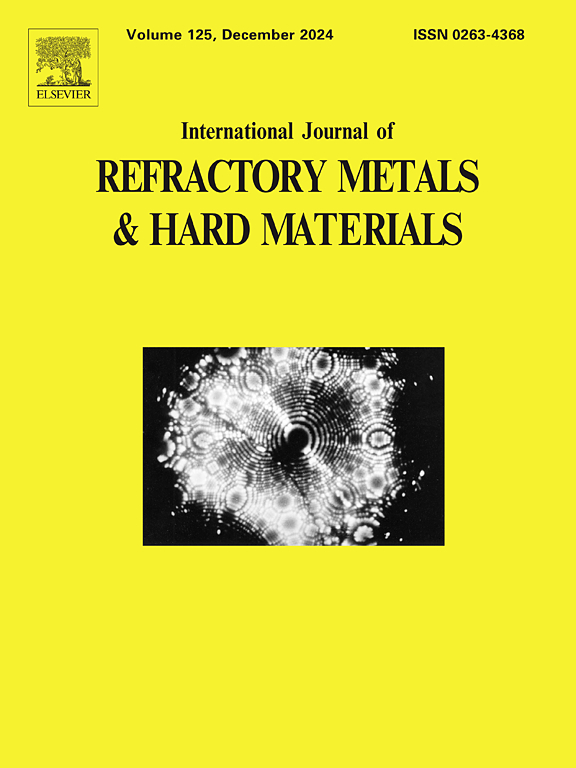CuTa射流成分比和微观结构对侵彻性能的影响
IF 4.2
2区 材料科学
Q2 MATERIALS SCIENCE, MULTIDISCIPLINARY
International Journal of Refractory Metals & Hard Materials
Pub Date : 2025-03-25
DOI:10.1016/j.ijrmhm.2025.107164
引用次数: 0
摘要
本研究的目的是探索cu - ta合金聚能射流在反装甲作战中的潜在应用,并填补该领域的一些研究空白。研究了成分比和微观组织对CuTa射流侵彻性能的影响。制备了Ta浓度分别为20 wt% (Cu20Ta)、40 wt% (Cu40Ta)和80 wt% (Cu80Ta)的CuTa合金。使用扫描电子显微镜、通用材料试验机和分离式霍普金森压力棒对材料进行分析。通过脉冲x射线和静态侵彻试验对CuTa射流的形貌和侵彻性能进行了表征。结果表明,三种材料均满足设计要求。Cu20Ta、Cu40Ta和Cu80Ta材料的准静态抗压强度分别比纯T2铜提高76.6%、140.1%和551.6%。这三种材料都能形成具有良好形貌的射流。随着Ta浓度的增加,三种射流的穿透深度先增大后减小。与纯T2铜射流相比,Cu20Ta、Cu40Ta和Cu80Ta射流的侵彻深度分别变化了15.1%、26.1%和- 56.4%。这些结果解释了控制CuTa合金穿透性能的机制,并确定了CuTa聚能射流的理想钽浓度范围在40% wt%左右。研究结果显示了cu - ta合金在反装甲作战中的应用潜力,为cu - ta合金在反装甲领域的应用奠定了基础。本文章由计算机程序翻译,如有差异,请以英文原文为准。
Influence of composition ratio and microstructure of CuTa jets on penetration performance
The goal of this study was to explore the potential application of Cu-Ta-alloy shaped-charged jets to anti-armor operations, as well as to fill some of the research gaps in this field. The effects of composition ratios and microstructures on the penetration performance of Cu![]() Ta jets were investigated. Cu
Ta jets were investigated. Cu![]() Ta alloys with Ta concentrations of 20 wt% (Cu
Ta alloys with Ta concentrations of 20 wt% (Cu![]() 20Ta), 40 wt% (Cu
20Ta), 40 wt% (Cu![]() 40Ta), and 80 wt% (Cu
40Ta), and 80 wt% (Cu![]() 80Ta) were prepared. The materials were analysed using scanning electron microscopy, a universal material testing machine, and a split Hopkinson pressure bar. The morphologies and penetration performance of the Cu
80Ta) were prepared. The materials were analysed using scanning electron microscopy, a universal material testing machine, and a split Hopkinson pressure bar. The morphologies and penetration performance of the Cu![]() Ta jets were characterized by pulsed X-ray and static penetration tests. The results indicated that all three materials met the design requirements. The quasi-static compression strengths of the Cu
Ta jets were characterized by pulsed X-ray and static penetration tests. The results indicated that all three materials met the design requirements. The quasi-static compression strengths of the Cu![]() 20Ta, Cu
20Ta, Cu![]() 40Ta, and Cu
40Ta, and Cu![]() 80Ta materials were 76.6 %, 140.1 %, and 551.6 % greater, respectively, than that of pure T2 copper. All three materials could form jets with good morphologies. The penetration depths of the three jets first increased and then decreased as the Ta concentration increased. The penetration depths of the Cu
80Ta materials were 76.6 %, 140.1 %, and 551.6 % greater, respectively, than that of pure T2 copper. All three materials could form jets with good morphologies. The penetration depths of the three jets first increased and then decreased as the Ta concentration increased. The penetration depths of the Cu![]() 20Ta, Cu
20Ta, Cu![]() 40Ta, and Cu
40Ta, and Cu![]() 80Ta jets changed by 15.1 %, 26.1 %, and − 56.4 %, respectively, from that of a pure T2 copper jet. These results explain the mechanisms that governed the penetration performance of the Cu
80Ta jets changed by 15.1 %, 26.1 %, and − 56.4 %, respectively, from that of a pure T2 copper jet. These results explain the mechanisms that governed the penetration performance of the Cu![]() Ta alloys, and it was determined that the ideal tantalum-concentration range for the Cu
Ta alloys, and it was determined that the ideal tantalum-concentration range for the Cu![]() Ta shaped-charge jets was centred around 40 wt%. The results of this study demonstrate the potential for Cu-Ta-alloy utilization in anti-armor operations and lay a foundation for the application of Cu
Ta shaped-charge jets was centred around 40 wt%. The results of this study demonstrate the potential for Cu-Ta-alloy utilization in anti-armor operations and lay a foundation for the application of Cu![]() Ta alloys in the anti-armor field.
Ta alloys in the anti-armor field.
求助全文
通过发布文献求助,成功后即可免费获取论文全文。
去求助
来源期刊
CiteScore
7.00
自引率
13.90%
发文量
236
审稿时长
35 days
期刊介绍:
The International Journal of Refractory Metals and Hard Materials (IJRMHM) publishes original research articles concerned with all aspects of refractory metals and hard materials. Refractory metals are defined as metals with melting points higher than 1800 °C. These are tungsten, molybdenum, chromium, tantalum, niobium, hafnium, and rhenium, as well as many compounds and alloys based thereupon. Hard materials that are included in the scope of this journal are defined as materials with hardness values higher than 1000 kg/mm2, primarily intended for applications as manufacturing tools or wear resistant components in mechanical systems. Thus they encompass carbides, nitrides and borides of metals, and related compounds. A special focus of this journal is put on the family of hardmetals, which is also known as cemented tungsten carbide, and cermets which are based on titanium carbide and carbonitrides with or without a metal binder. Ceramics and superhard materials including diamond and cubic boron nitride may also be accepted provided the subject material is presented as hard materials as defined above.

 求助内容:
求助内容: 应助结果提醒方式:
应助结果提醒方式:


